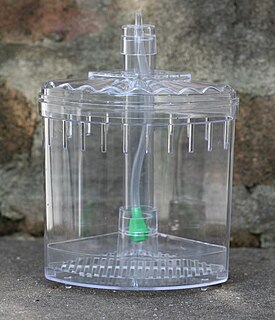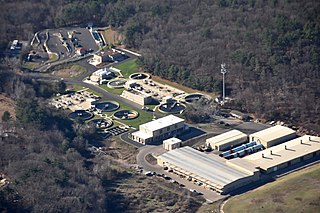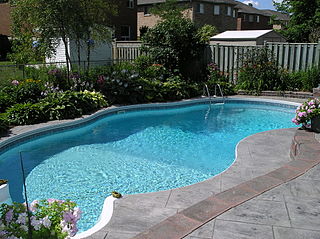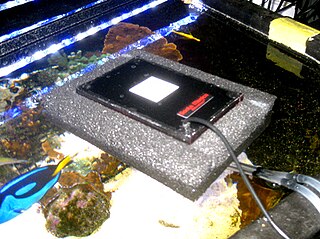Related Research Articles

A cell wall is a structural layer surrounding some types of cells, just outside the cell membrane. It can be tough, flexible, and sometimes rigid. It provides the cell with both structural support and protection, and also acts as a filtering mechanism. Cell walls are present in most prokaryotes, in algae, fungi and eukaryotes including plants but are absent in animals. A major function is to act as pressure vessels, preventing over-expansion of the cell when water enters.

Water purification is the process of removing undesirable chemicals, biological contaminants, suspended solids, and gases from water. The goal is to produce water fit for specific purposes. Most water is purified and disinfected for human consumption, but water purification may also be carried out for a variety of other purposes, including medical, pharmacological, chemical, and industrial applications. The methods used include physical processes such as filtration, sedimentation, and distillation; biological processes such as slow sand filters or biologically active carbon; chemical processes such as flocculation and chlorination; and the use of electromagnetic radiation such as ultraviolet light.

A unicellular organism, also known as a single-celled organism, is an organism that consists of a single cell, unlike a multicellular organism that consists of multiple cells. Unicellular organisms fall into two general categories: prokaryotic organisms and eukaryotic organisms. All prokaryotes are unicellular and are classified into bacteria and archaea. Many eukaryotes are multicellular, but many are unicellular such as protozoa, unicellular algae, and unicellular fungi. Unicellular organisms are thought to be the oldest form of life, with early protocells possibly emerging 3.8–4 billion years ago.

Disinfectants are chemical agents designed to inactivate or destroy microorganisms on inert surfaces. Disinfection does not necessarily kill all microorganisms, especially resistant bacterial spores; it is less effective than sterilization, which is an extreme physical or chemical process that kills all types of life. Disinfectants are generally distinguished from other antimicrobial agents such as antibiotics, which destroy microorganisms within the body, and antiseptics, which destroy microorganisms on living tissue. Disinfectants are also different from biocides—the latter are intended to destroy all forms of life, not just microorganisms. Disinfectants work by destroying the cell wall of microbes or interfering with their metabolism. It is also a form of decontamination, and can be defined as the process whereby physical or chemical methods are used to reduce the amount of pathogenic microorganisms on a surface.

Listeria is a genus of bacteria that acts as an intracellular parasite in mammals. Until 1992, 10 species were known, each containing two subspecies. By 2020, 21 species had been identified. The genus received its current name, after the British pioneer of sterile surgery Joseph Lister, in 1940. Listeria species are Gram-positive, rod-shaped, and facultatively anaerobic, and do not produce endospores. The major human pathogen in the genus Listeria is L. monocytogenes. It is usually the causative agent of the relatively rare bacterial disease listeriosis, an infection caused by eating food contaminated with the bacteria. Listeriosis can cause serious illness in pregnant women, newborns, adults with weakened immune systems and the elderly, and may cause gastroenteritis in others who have been severely infected.
An antimicrobial is an agent that kills microorganisms or stops their growth. Antimicrobial medicines can be grouped according to the microorganisms they act primarily against. For example, antibiotics are used against bacteria, and antifungals are used against fungi. They can also be classified according to their function. Agents that kill microbes are microbicides, while those that merely inhibit their growth are called bacteriostatic agents. The use of antimicrobial medicines to treat infection is known as antimicrobial chemotherapy, while the use of antimicrobial medicines to prevent infection is known as antimicrobial prophylaxis.
A slime layer in bacteria is an easily removable, unorganized layer of extracellular material that surrounds bacteria cells. Specifically, this consists mostly of exopolysaccharides, glycoproteins, and glycolipids. Therefore, the slime layer is considered as a subset of glycocalyx.
Microbial intelligence is the intelligence shown by microorganisms. The concept encompasses complex adaptive behavior shown by single cells, and altruistic or cooperative behavior in populations of like or unlike cells mediated by chemical signalling that induces physiological or behavioral changes in cells and influences colony structures.
A water tank is a container for storing water.
The bacterium, despite its simplicity, contains a well-developed cell structure which is responsible for some of its unique biological structures and pathogenicity. Many structural features are unique to bacteria and are not found among archaea or eukaryotes. Because of the simplicity of bacteria relative to larger organisms and the ease with which they can be manipulated experimentally, the cell structure of bacteria has been well studied, revealing many biochemical principles that have been subsequently applied to other organisms.

Emmett W. Chappelle was an American scientist who made valuable contributions in the fields of medicine, philanthropy, food science, and astrochemistry. His achievements led to his induction into the National Inventors Hall of Fame for his work on Bio-luminescence, in 2007. Being honored as one of the 100 most distinguished African American scientists of the 20th Century, he was also one of the members of the American Chemical Society, the American Society of Biochemistry and Molecular Biology, the American Society of Photobiology, the American Society of Microbiology, and the American Society of Black Chemists.

A garden pond is a water feature constructed in a garden or designed landscape, normally for aesthetic purposes, to provide wildlife habitat, or for swimming.

Aquarium filters are critical components of both freshwater and marine aquaria. Aquarium filters remove physical and soluble chemical waste products from aquaria, simplifying maintenance. Furthermore, aquarium filters are necessary to support life as aquaria are relatively small, closed volumes of water compared to the natural environment of most fish.
Swimming pool sanitation is the process of ensuring healthy conditions in swimming pools. Proper sanitation is needed to maintain the visual clarity of water and to prevent the transmission of infectious waterborne diseases.

Sewage treatment is the process of removing contaminants from municipal wastewater, containing mainly household sewage plus some industrial wastewater. Physical, chemical, and biological processes are used to remove contaminants and produce treated wastewater that is safe enough for release into the environment. A by-product of sewage treatment is a semi-solid waste or slurry, called sewage sludge. The sludge has to undergo further treatment before being suitable for disposal or application to land.

Mold prevention is a conservation activity that is performed in libraries to protect books and other materials from deterioration caused by mold growth. Mold prevention consists of different methods, such as chemical treatments, careful environmental control, and manual cleaning. Preservationists use one or a combination of these methods to combat mold spores in library collections.

A swimming pool, swimming bath, wading pool, paddling pool, or simply pool is a structure designed to hold water to enable swimming or other leisure activities. Pools can be built into the ground or built above ground, and may be found as a feature aboard ocean-liners and cruise ships. In-ground pools are most commonly constructed from materials such as concrete, natural stone, metal, plastic, or fiberglass, and can be of a custom size and shape or built to a standardized size, the largest of which is the Olympic-size swimming pool.

An algae scrubber is a water filtering device which uses light to grow algae; in this process, undesirable chemicals are removed from the water. Algae scrubbers allow saltwater, freshwater and pond hobbyists to operate their tanks using natural filtration in the form of primary production, much like oceans and lakes.
Soil microbiology is the study of microorganisms in soil, their functions, and how they affect soil properties. It is believed that between two and four billion years ago, the first ancient bacteria and microorganisms came about on Earth's oceans. These bacteria could fix nitrogen, in time multiplied, and as a result released oxygen into the atmosphere. This led to more advanced microorganisms, which are important because they affect soil structure and fertility. Soil microorganisms can be classified as bacteria, actinomycetes, fungi, algae and protozoa. Each of these groups has characteristics that define them and their functions in soil.
Slimicide is a broad-spectrum antimicrobial pesticide used to kill slime-producing microorganisms such as algae, bacteria, fungi,and slime molds. One primary application domain is in the papermaking industry, where it reduces the occurrence of paper holes and spots, as well as protecting the machinery from odor, clogs, corrosion, and breakdown. Slimicides come in variants effective in acidic and/or alkaline media, in liquid or solid form, and are based on chemicals such as aldehydes, bromium or quaternary ammonium compounds, and others. Additional significant application areas for slimicides include industrial water recirculation systems such as cooling towers, fuel storage tanks and wells, and in conjunction with fluids used for oil extraction. In some application domains, slimicides may be formulated specifically to target slime molds.
References
- ↑ Johnson, Maggie D. "Coralline Algae: The Unsung Architects of Coral Reefs". ocean.si.edu. Retrieved 2019-05-29.
- ↑ "pink pool algae, pink algae-mold, pink-white pool slime". www.askalanaquestion.com. Retrieved 2019-05-29.
- ↑ "Swimming Pool Algae – what causes it, and how to kill pool algae". www.poolcenter.com. Retrieved 2019-05-29.
- ↑ "Algae & How to get rid of it". Aquatic Community. Retrieved 2019-05-29.